Combined Effects of Synoptic-Scale Teleconnection Patterns on Summer Precipitation in Southern China
Abstract
:1. Introduction
2. Data and Methods
2.1. Data
2.2. Methods
3. Combined Effects of Teleconnection Patterns on Summer Precipitation in Southern China
3.1. Definition and Identification of Typical Events
3.2. Spatial Distribution of Precipitation in Southern China
4. Corresponding Anomalous Circulation Patterns
4.1. Upper-Level Divergence
4.2. Anomalous Circulation in the Middle Troposphere
4.3. Low-Level Moisture Transport and Vertical Motion
5. Discussion and Conclusions
Acknowledgments
Author Contributions
Conflicts of Interest
References
- Huang, R.H. The numerical simulation of the three-dimensional teleconnections in the summer circulation over the Northern Hemisphere. Adv. Atmos. Sci. 1985, 2, 81–92. [Google Scholar] [CrossRef]
- Nitta, T. Convective activities in the tropical western Pacific and their impact on the Northern Hemisphere summer circulation. J. Meteorol. Soc. Jpn. 1987, 65, 373–390. [Google Scholar] [CrossRef]
- Kurihara, K. A climatological study on the relationship between the Japanese summer weather and the subtropical high in the western North Pacific. Geophys. Mag. 1989, 43, 45–104. [Google Scholar]
- Kosaka, Y.; Nakamura, H. Structure and dynamics of the summertime Pacific–Japan teleconnection pattern. Q. J. R. Meteorol. Soc. 2006, 132, 2009–2030. [Google Scholar] [CrossRef]
- Bueh, C.; Shi, N.; Ji, L.R.; Wei, J.; Tao, S.Y. Features of the EAP events on the medium-range evolution process and the mid-and high-latitude Rossby wave activities during the Meiyu period. Chin. Sci. Bull. 2008, 53, 610–623. [Google Scholar] [CrossRef]
- Enomoto, T.; Hoskins, B.J.; Matsuda, Y. The formation mechanism of the Bonin high in August. Q. J. R. Meteorol. Soc. 2003, 129, 157–178. [Google Scholar] [CrossRef]
- Guan, Z.Y.; Yamagata, T. The unusual summer of 1994 in East Asia: IOD teleconnections. Geophys. Res. Lett. 2003, 30, 235–250. [Google Scholar] [CrossRef]
- Ding, Q.H.; Wang, B. Circumglobal teleconnection in the Northern Hemisphere summer. J. Clim. 2005, 18, 3483–3505. [Google Scholar] [CrossRef]
- Ding, Q.H.; Wang, B. Intraseasonal teleconnection between the summer Eurasian wave train and the Indian Monsoon. J. Clim. 2007, 20, 3751–3767. [Google Scholar] [CrossRef]
- Lau, K.M.; Kim, K.M.; Yang, S. Dynamical and boundary forcing characteristics of regional components of the Asian summer monsoon. J. Clim. 2000, 13, 2461–2482. [Google Scholar] [CrossRef]
- Huang, R.H.; Sun, F.Y. Impact of the convective activities over the western tropical Pacific warm pool on the intraseasonal variability of the East Asian summer monsoon. Chin. J. Atmos. Sci. 1994, 146, 289–296. (In Chinese) [Google Scholar]
- Lau, K.M.; Weng, H. Recurrent teleconnection patterns linking summertime precipitation variability over East Asia and North America. J. Meteorol. Soc. Jpn. 2002, 80, 1309–1324. [Google Scholar] [CrossRef]
- Kosaka, Y.; Chowdary, J.S.; Xie, S.P.; Min, Y.M.; Lee, J.Y. Limitations of seasonal predictability for summer climate over East Asia and the Northwestern Pacific. J. Clim. 2012, 25, 7574–7589. [Google Scholar] [CrossRef]
- Krishnan, R.; Sugi, M. Baiu rainfall variability and associated monsoon teleconnections. J. Meteorol. Soc. Jpn. 2001, 79, 851–860. [Google Scholar] [CrossRef]
- Ye, H.; Lu, R.Y. Subseasonal variation in ENSO-related East Asian rainfall anomalies during summer and its role in weakening the relationship between the ENSO and summer rainfall in eastern China since the late 1970s. J. Clim. 2011, 24, 2271–2284. [Google Scholar] [CrossRef]
- Hong, X.W.; Lu, R.Y. The meridional displacement of the summer Asian jet, Silk Road pattern, and tropical SST anomalies. J. Clim. 2016, 29, 3753–3766. [Google Scholar] [CrossRef]
- Lu, R.Y.; Oh, J.H.; Kim, B.J. A teleconnection pattern in upper-level meridional wind over the North African and Eurasian continent in summer. Tellus A 2002, 54, 44–55. [Google Scholar] [CrossRef]
- Wang, N.; Zhang, Y.C. Evolution of Eurasian teleconnection pattern and its relationship to climate anomalies in China. Clim. Dyn. 2015, 44, 1017–1028. [Google Scholar] [CrossRef]
- Saeed, S.; Lipzig, N.V.; Müller, W.A.; Saeed, F.; Zanchettin, D. Influence of the circumglobal wave-train on European summer precipitation. Clim. Dyn. 2014, 43, 503–515. [Google Scholar] [CrossRef]
- Wakabayashi, S.; Kawamura, R. Extraction of major teleconnection patterns possibly associated with the anomalous summer climate in Japan. J. Meteorol. Soc. Jpn. 2004, 82, 1577–1588. [Google Scholar] [CrossRef]
- Kosaka, Y.; Nakamura, H. Mechanisms of meridional teleconnection observed between a summer monsoon system and a subtropical anticyclone. Part I: The Pacific–Japan pattern. J. Clim. 2010, 23, 5085–5108. [Google Scholar] [CrossRef]
- Ogasawara, T.; Kawamura, R. Effects of combined teleconnection patterns on the East Asian summer monsoon circulation: Remote forcing from low-and high-latitude regions. J. Meteorol. Soc. Jpn. 2008, 86, 491–504. [Google Scholar] [CrossRef]
- Hsu, H.H.; Lin, S.M. Asymmetry of the tripole rainfall pattern during the East Asian summer. J. Clim. 2007, 20, 4443–4458. [Google Scholar] [CrossRef]
- Kosaka, Y.; Xie, S.P.; Nakamura, H. Dynamics of interannual variability in summer precipitation over East Asia. J. Clim. 2011, 24, 5435–5453. [Google Scholar] [CrossRef]
- Chen, Y.; Zhai, P.M. Synoptic-scale precursors of the East Asia/Pacific teleconnection pattern responsible for persistent extreme precipitation in the Yangtze River Valley. Q. J. R. Meteorol. Soc. 2015, 141, 1389–1403. [Google Scholar] [CrossRef]
- Choi, K.S.; Wu, C.C.; Cha, E.J. Change of tropical cyclone activity by Pacific-Japan teleconnection pattern in the western North Pacific. J. Geophys. Res. Atmos. 2010, 115. [Google Scholar] [CrossRef]
- Ogasawara, T.; Kawamura, R. Combined effects of teleconnection patterns on anomalous summer weather in Japan. J. Meteorol. Soc. Jpn. 2007, 85, 11–24. [Google Scholar] [CrossRef]
- Chen, Y.; Zhai, P.M. Mechanisms for concurrent low-latitude circulation anomalies responsible for persistent extreme precipitation in the Yangtze River Valley. Clim. Dyn. 2016, 47, 989–1006. [Google Scholar] [CrossRef]
- Dee, D.P.; Uppala, S.M.; Simmons, A.J.; Berrisford, P.; Poli, P.; Kobayashi, S.; Andrae, U.; Balmaseda, M.A.; Balsamo, G.; Bauer, P.; et al. The ERA-Interim reanalysis: Configuration and performance of the data assimilation system. Q. J. R. Meteorol. Soc. 2011, 137, 553–597. [Google Scholar] [CrossRef]
- Zhong, S.X.; Chen, Z.T. The Impacts of atmospheric moisture transportation on warm sector torrential rains over South China. Atmosphere 2017, 8, 116. [Google Scholar] [CrossRef]
- National Meteorological Information Center. Assessment Report of China's Ground Precipitation 0.5° × 0.5° Gridded Dataset (V2.0); Assessment Report of China’s Ground; National Meteorological Information Center: Beijing, China, 2010. [Google Scholar]
- Hutchinson, M.F. Interpolation of rainfall data with thin plate smoothing splines-part I: Two dimensional smoothing of data with short range correlation. J. Geogr. Inf. Decis. Anal. 1998, 2, 153–167. [Google Scholar]
- Grumm, R.H.; Hart, R.H. Standardized anomalies applied to significant cold season weather events: Preliminary findings. Weather Forecast. 2001, 16, 736–754. [Google Scholar] [CrossRef]
- Yanai, M.; Esbensen, S.; Chu, J.H. Determination of bulk properties of tropical cloud clusters from large-scale heat and moisture budgets. J. Atmos. Sci. 1973, 30, 611–627. [Google Scholar] [CrossRef]
- Ren, X.J.; Yang, X.Q.; Sun, X.G. Zonal oscillation of western Pacific subtropical high and subseasonal SST variations during Yangtze persistent heavy rainfall events. J. Clim. 2013, 26, 8929–8946. [Google Scholar] [CrossRef]
- Archambault, H.M.; Keyser, D.; Bosart, L.F. Relationships between large-scale regime transitions and major cool-season precipitation events in the northeastern United States. Mon. Weather Rev. 2010, 138, 3454–3473. [Google Scholar] [CrossRef]
- Uccellini, L.W.; Kocin, P.J. The interaction of jet streak circulations during heavy snow events along the east coast of the United States. Weather Forecast. 1987, 2, 289–308. [Google Scholar] [CrossRef]
- Liu, J.P.; Ren, H.L.; Li, W.J.; Zuo, J.Q. Remarkable impacts of Indian Ocean sea surface temperature on interdecadal variability of summer rainfall in Southwestern China. Atmosphere 2018, 9, 103. [Google Scholar] [CrossRef]
- Holton, J.R. An Introduction to Dynamic Meteorology, 4th ed.; Academic Press: Burlington, VT, USA, 2004; pp. 146–147. [Google Scholar]
- Lu, R.Y.; Lin, Z.D. Role of subtropical precipitation anomalies in maintaining the summertime meridional teleconnection over the western North Pacific and East Asia. J. Clim. 2009, 22, 2058–2072. [Google Scholar] [CrossRef]
- Jin, Q.; Yang, X.Q.; Sun, X.G.; Fang, J.B. East Asian summer monsoon circulation structure controlled by feedback of condensational heating. Clim. Dyn. 2013, 41, 1885–1897. [Google Scholar] [CrossRef]
- He, J.H.; Zhao, P.; Zhu, C.W.; Zhang, R.H.; Tang, X.; Chen, L.X. Discussions on the East Asian subtropical monsoon. Acta Meteorol. Sin. 2008, 66, 683–696. (In Chinese) [Google Scholar]
- Ren, H.L.; Ren, P.F. Impact of Madden–Julian Oscillation upon winter extreme rainfall in Southern China: Observations and predictability in CFSv2. Atmosphere 2017, 8, 192. [Google Scholar] [CrossRef]
- Wang, B.; Xie, X.S. Low-frequency equatorial waves in vertically sheared zonal flow. Part I: Stable waves. J. Atmos. Sci. 1996, 53, 449–467. [Google Scholar] [CrossRef]
- Chen, Y.; Zhai, P.M. Simultaneous modulations of precipitation and temperature extremes in Southern parts of China by the boreal summer intraseasonal oscillation. Clim. Dyn. 2017, 49, 3363–3381. [Google Scholar] [CrossRef]
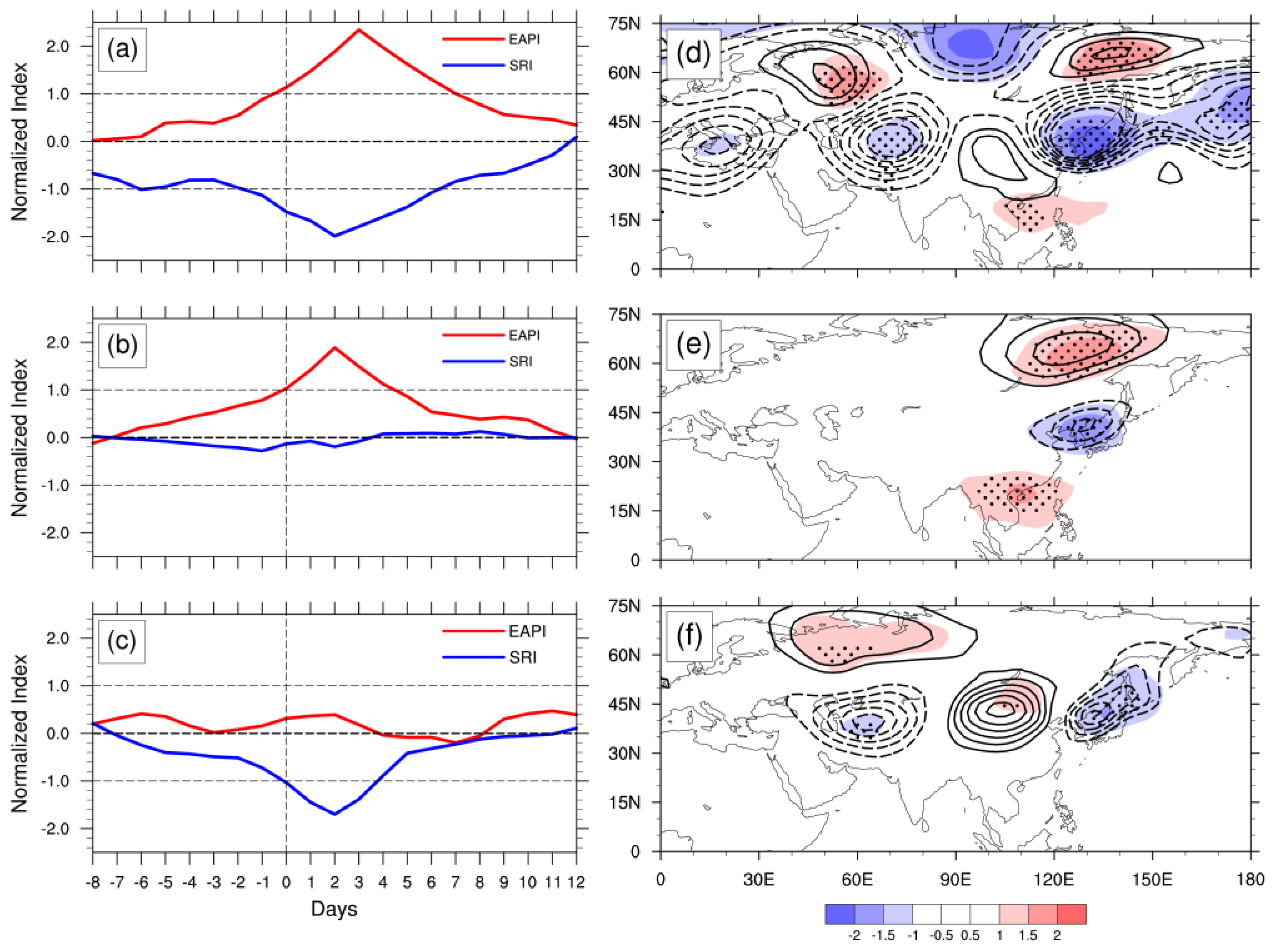



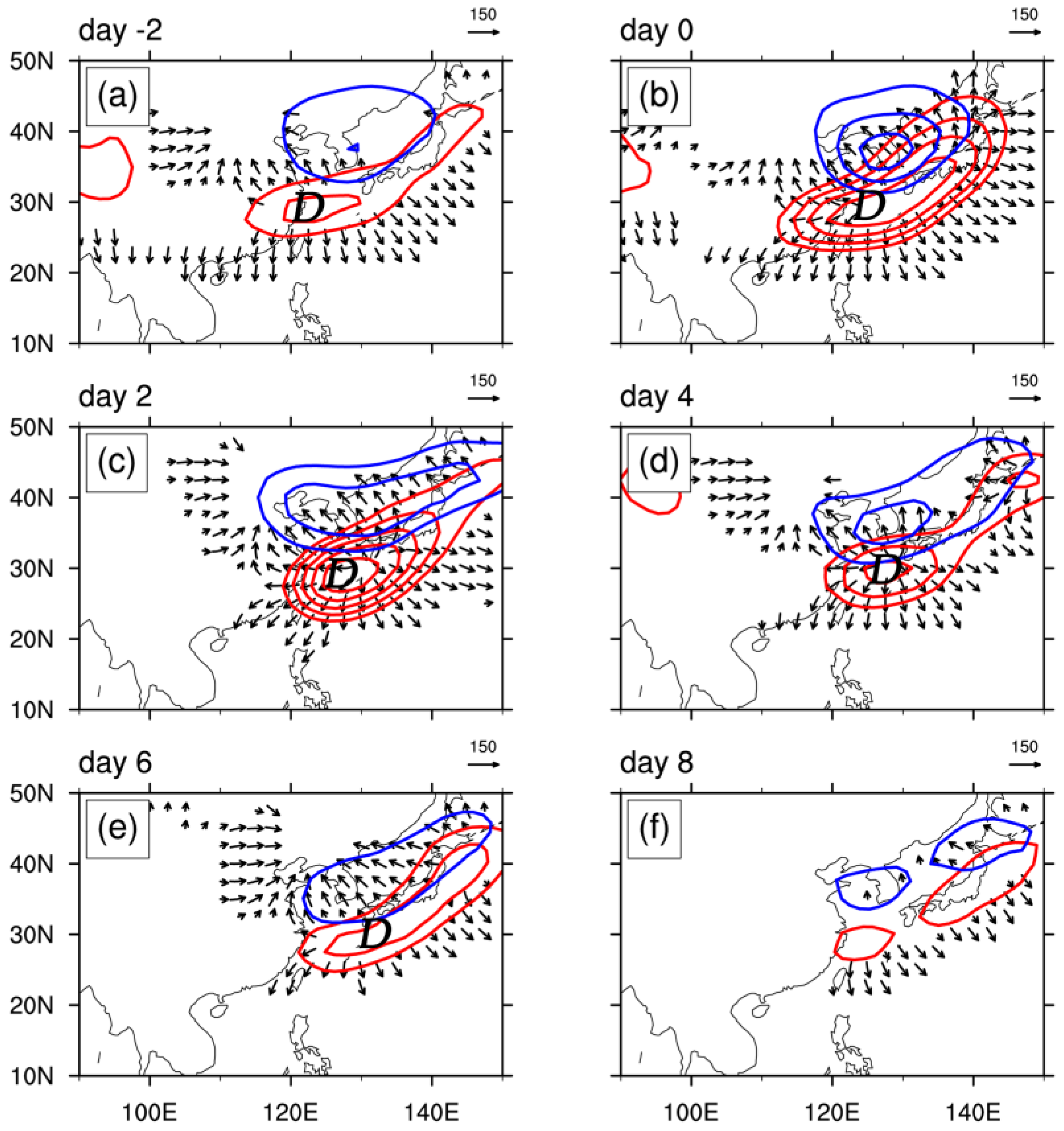
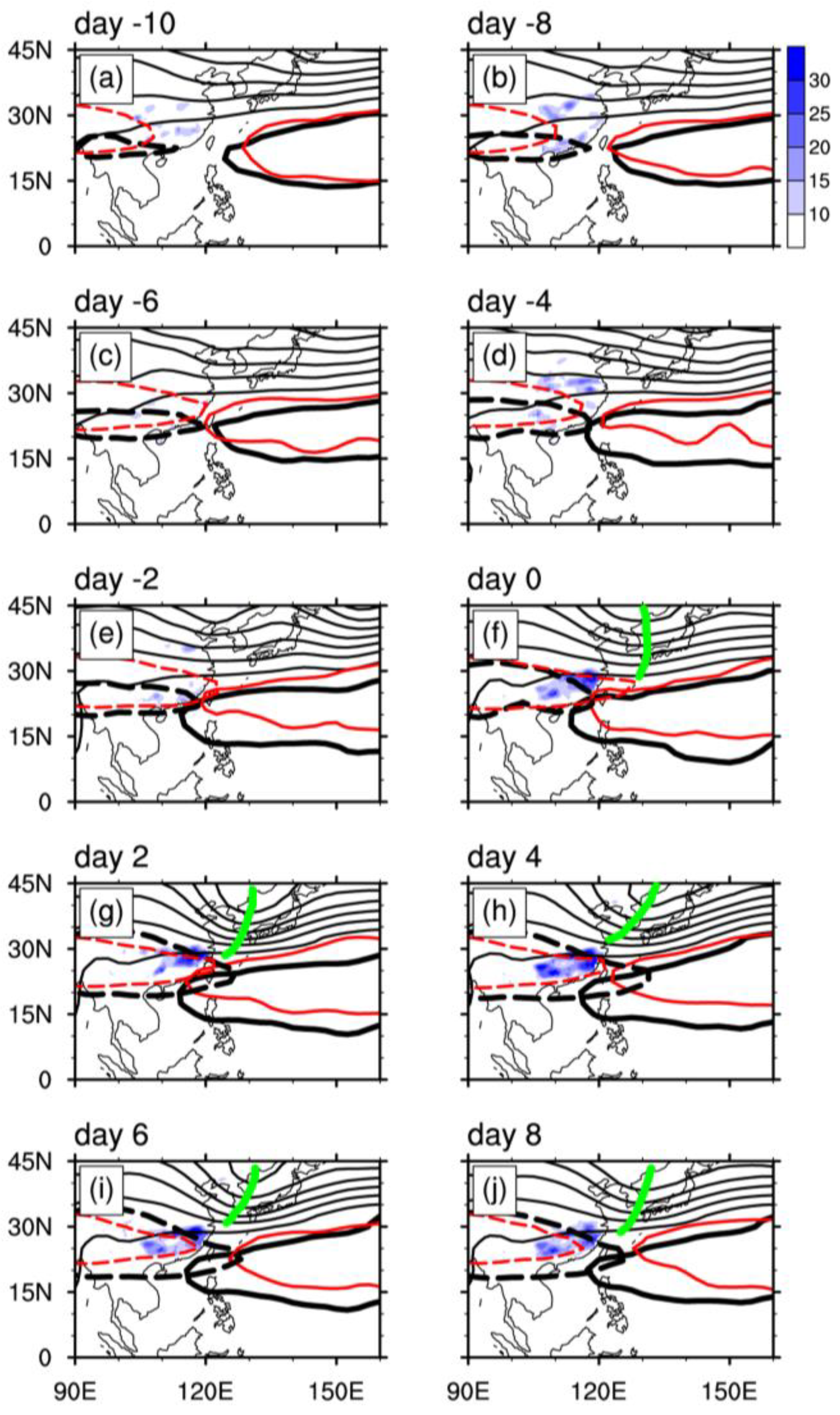
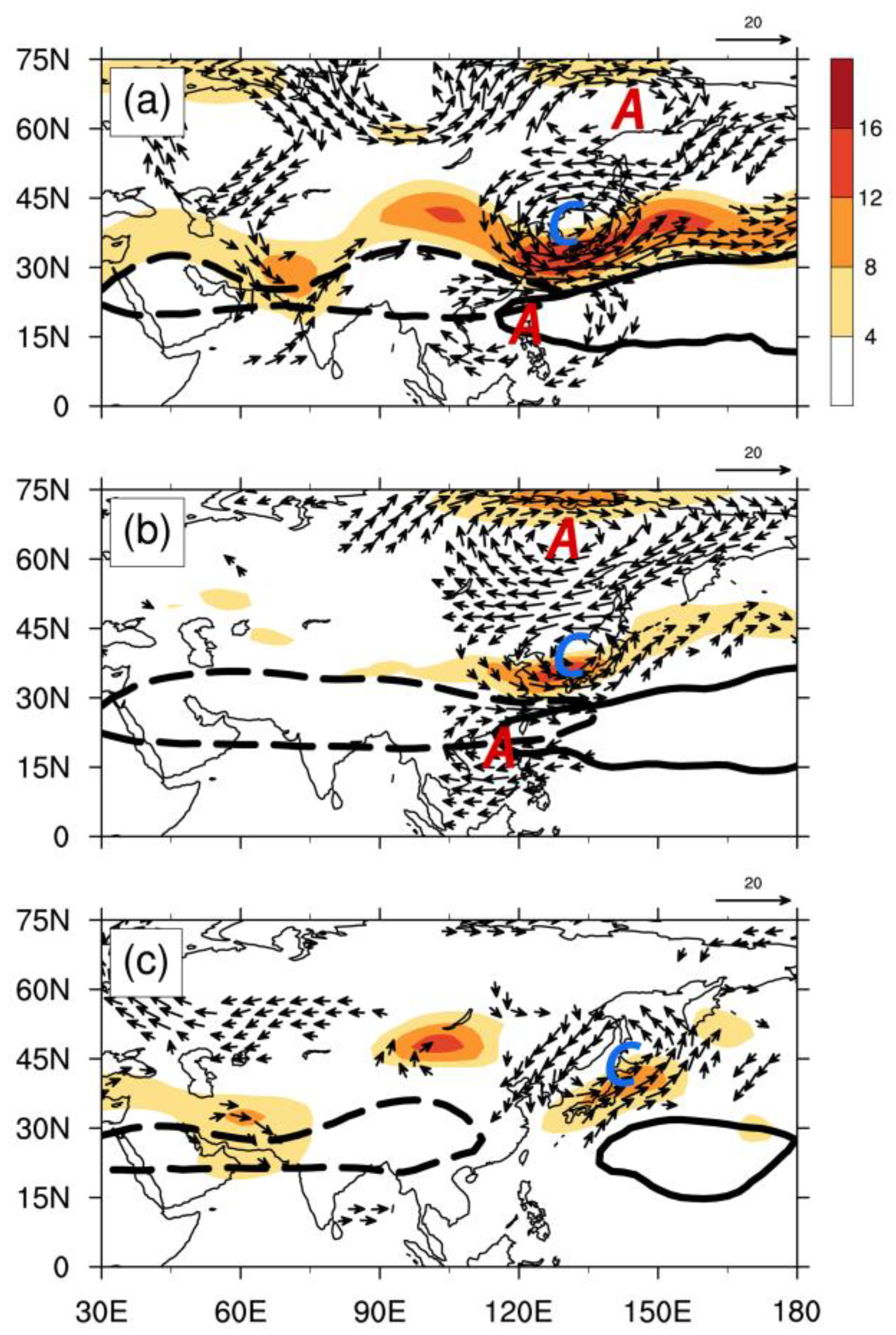
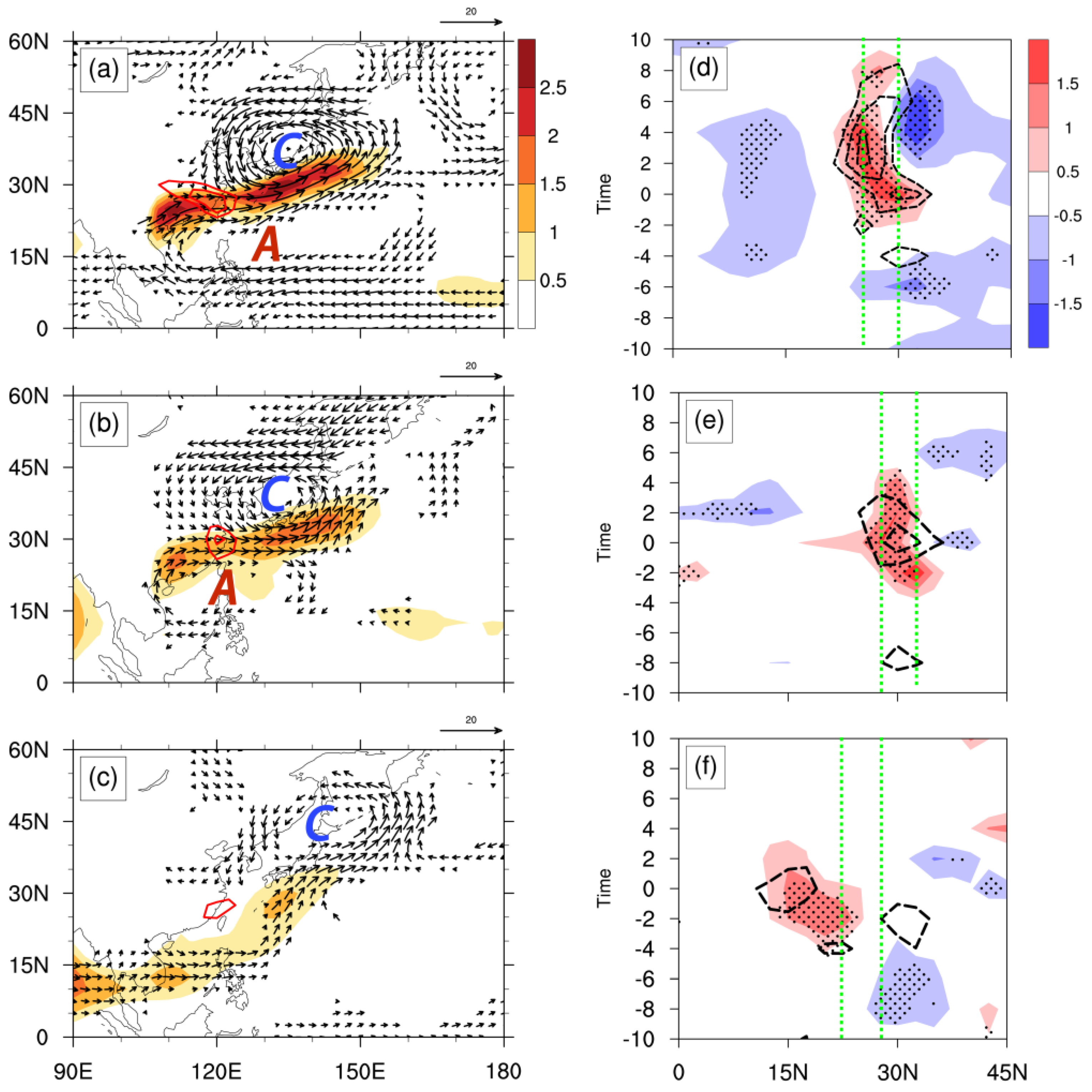
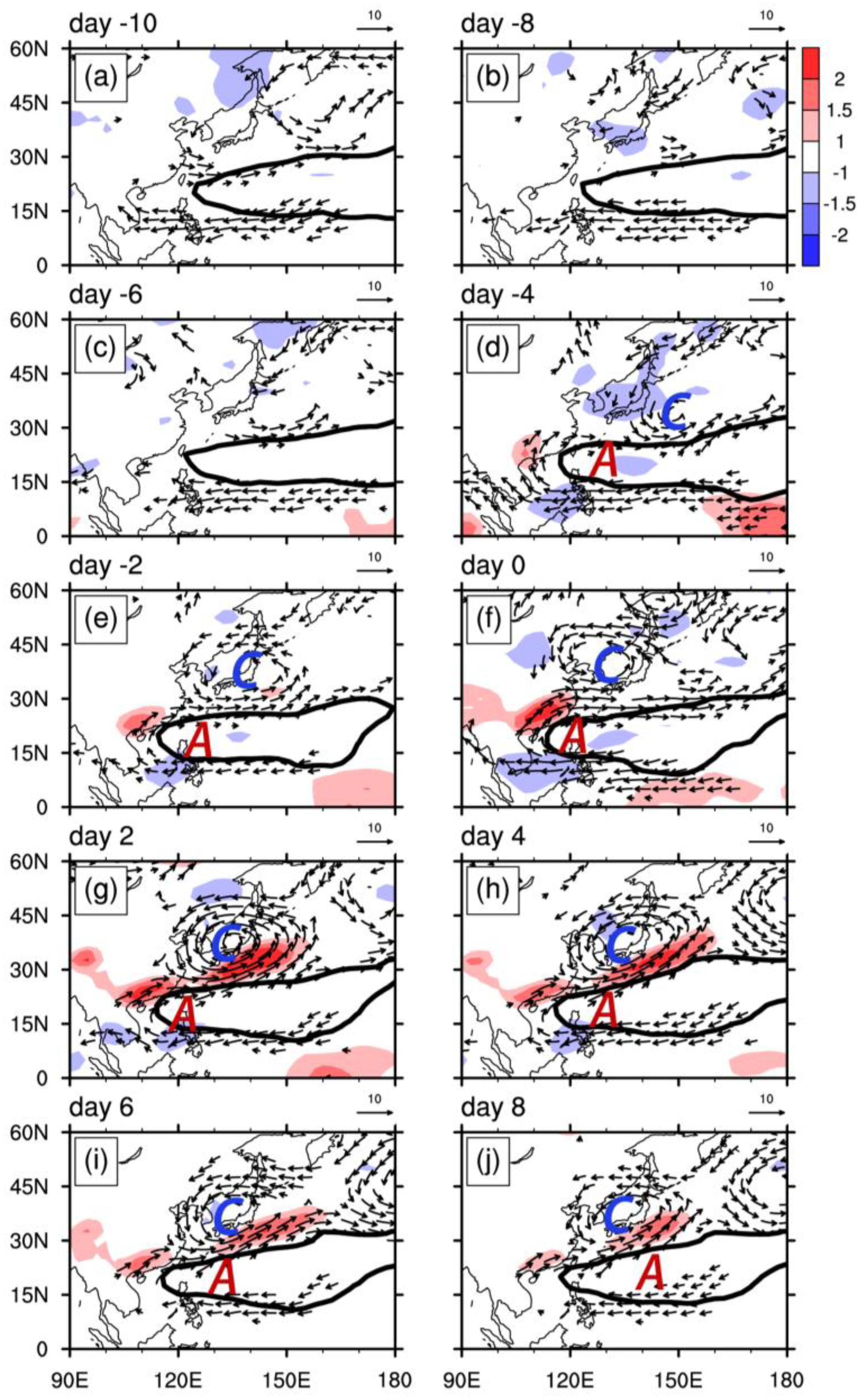


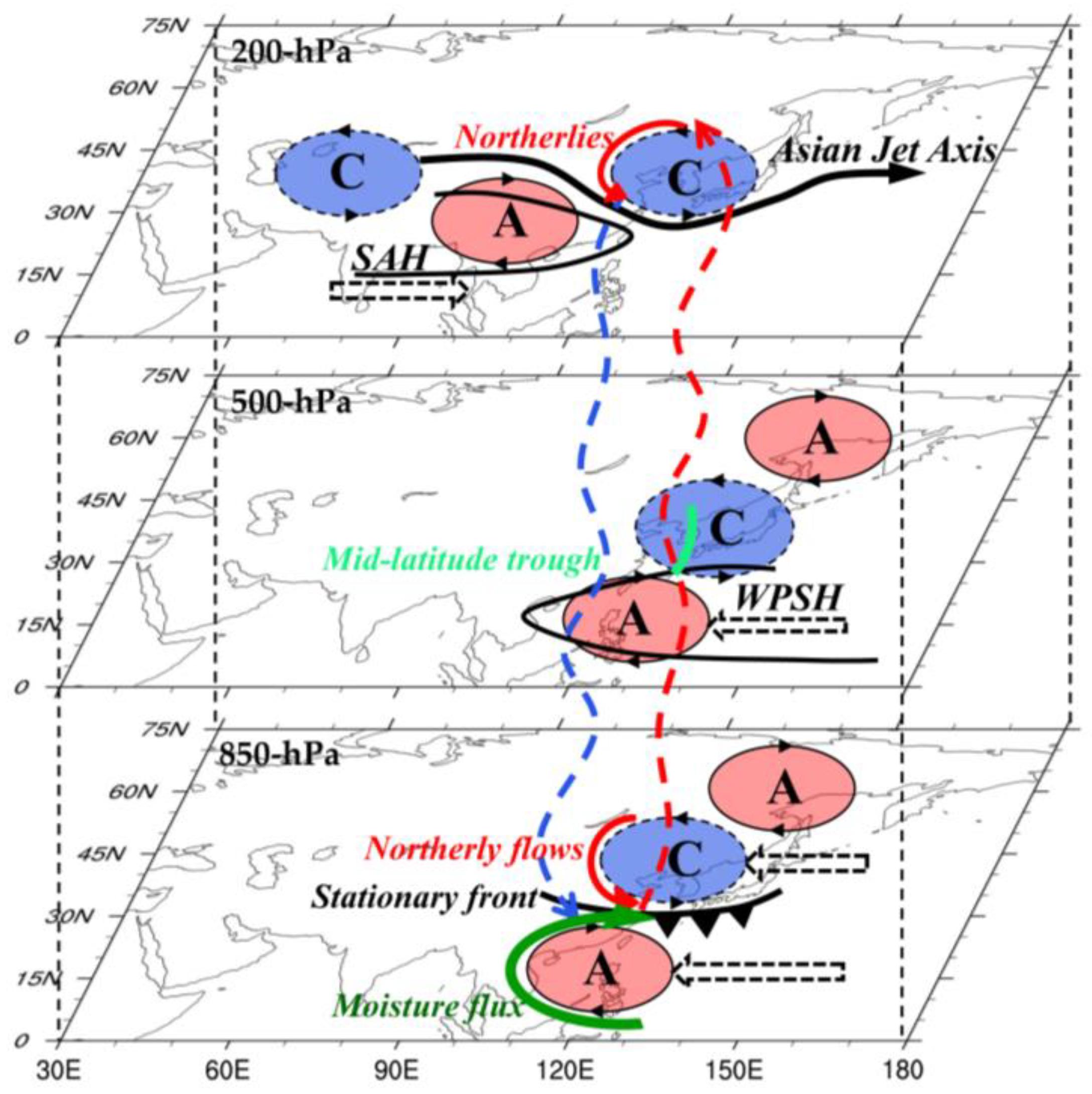
| No. | EAP-S | SR-S | EAP/SR-C | ||||||
|---|---|---|---|---|---|---|---|---|---|
| Year | Start Date | End Date | Year | Start Date | End Date | Year | Start Date | End Date | |
| 1 | 1979 | 2 July | 4 July | 1982 | 7 July | 9 July | 1979 | 8 June | 11 June |
| 2 | 1980 | 24 July | 31 July | 1985 | 29 June | 1 July | 1982 | 24 June | 28 June |
| 3 | 1980 | 13 August | 15 August | 1990 | 10 June | 14 June | 1983 | 5 July | 10 July |
| 4 | 1982 | 18 July | 24 July | 1992 | 8 August | 13 August | 1985 | 11 June | 13 June |
| 5 | 1983 | 27 June | 30 June | 1994 | 11 June | 17 June | 1987 | 9 June | 16 June |
| 6 | 1986 | 6 July | 9 July | 1997 | 11 June | 15 June | 1988 | 16 June | 19 June |
| 7 | 1991 | 4 July | 10 July | 1997 | 4 August | 6 August | 1989 | 16 June | 21 June |
| 8 | 1993 | 14 July | 21 July | 2000 | 18 July | 20 July | 1991 | 19 June | 25 June |
| 9 | 1998 | 19 July | 1 August | 2002 | 7 July | 17 July | 1992 | 7 June | 19 June |
| 10 | 1998 | 24 August | 31 August | 2005 | 10 June | 21 June | 1993 | 2 June | 5 June |
| 11 | 1999 | 14 July | 18 July | 2009 | 23 August | 25 August | 1995 | 23 June | 28 June |
| 12 | 2011 | 21 August | 23 August | 2010 | 22 June | 24 June | 1996 | 17 June | 20 June |
| 13 | 2012 | 10 July | 14 July | 2013 | 16 June | 20 June | 1998 | 9 June | 18 June |
| 14 | 2014 | 11 July | 16 July | - | - | - | 1999 | 18 June | 20 June |
| 15 | 2014 | 10 August | 12 August | - | - | - | 2000 | 6 June | 11 June |
| 16 | 2015 | 10 June | 13 June | - | - | - | 2002 | 12 June | 18 June |
| 17 | 2015 | 30 June | 3 July | - | - | - | 2006 | 8 June | 16 June |
| 18 | - | - | - | - | - | - | 2009 | 10 June | 17 June |
| 19 | - | - | - | - | - | - | 2010 | 5 July | 12 July |
| 20 | - | - | - | - | - | - | 2012 | 8 June | 13 June |
| 21 | - | - | - | - | - | - | 2014 | 9 June | 16 June |
© 2018 by the authors. Licensee MDPI, Basel, Switzerland. This article is an open access article distributed under the terms and conditions of the Creative Commons Attribution (CC BY) license (http://creativecommons.org/licenses/by/4.0/).
Share and Cite
Wang, C.; Wang, L. Combined Effects of Synoptic-Scale Teleconnection Patterns on Summer Precipitation in Southern China. Atmosphere 2018, 9, 154. https://doi.org/10.3390/atmos9040154
Wang C, Wang L. Combined Effects of Synoptic-Scale Teleconnection Patterns on Summer Precipitation in Southern China. Atmosphere. 2018; 9(4):154. https://doi.org/10.3390/atmos9040154
Chicago/Turabian StyleWang, Chao, and Lijuan Wang. 2018. "Combined Effects of Synoptic-Scale Teleconnection Patterns on Summer Precipitation in Southern China" Atmosphere 9, no. 4: 154. https://doi.org/10.3390/atmos9040154




